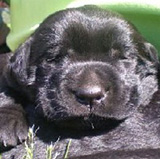The AKC Standard Look For Showing Your Lab
The general appearance of the Labrador should be that of a strongly built and a very active dog. He should be fairly wide over the loins and strong and muscular in the hindquarters.
The coat should be close, short, dense and free from feather.
The skull should be wide, giving brain room; there should be a slight stop, the brow should be slightly pronounced so that the skull is not absolutely in a straight line with the nose.
The head should be clean-cut and free from fleshy cheeks. The jaws should be long and powerful; the nose should be wide and the nostrils are well developed. Teeth should be strong and regular.
The ears should hang moderately close to the head, rather far back, should be set somewhat low and not be large and heavy.
The eyes should be of a medium size, expressing great intelligence and good temper, and can be brown, yellow or black, but brown or black is preferred.
The neck should be medium length, powerful and not throaty. The shoulders should be long and sloping.
The chest must be of good width and depth, the ribs are well sprung and the loins wide and strong, stifles are well turned, and the hindquarters are well developed and of great power.
The legs must be straight from the shoulder to ground, and the feet compact with toes well arched, and pads well developed; the hocks should be well bent, and the dog must neither be cow hocked nor be too wide behind; he must stand and move true all round on legs and feet. Legs should be of medium length, showing good bone and muscle, but not so short as to be out of balance with rest of body.
The tail is a distinctive feature of the breed; it should be very thick towards the base, gradually tapering towards the tip, of medium length, should be free from any feathering, and should be clothed thickly all round with the Labrador’s short, thick, dense coat, thus giving the peculiar “rounded” appearance which has been described as the “otter” tail. The tail may be carried gaily but should not curl over the back.
The coat is another very distinctive feature; it should be short, very dense and without wave, and should give a fairly hard feeling to the hand.
Movement should be free and effortless. The forelegs should be strong and true, and correctly placed. Watching a dog move towards one, there should be no signs of elbows being out in front, but neatly held to the body with legs not too close together, and moving straight forward without pacing or weaving. When viewing the dog from the rear, you should get the impression that the hind legs, which should be well muscled and not cow hocked, move as nearly parallel as possible, with hocks doing their full share of work and flexing well, thus giving the appearance of power and strength.
Return from Showing Your Lab to learning about your Labrador
